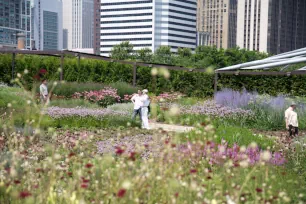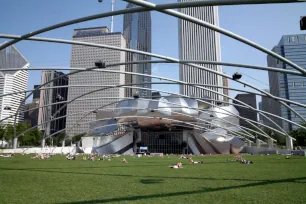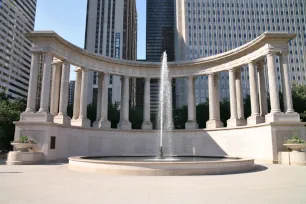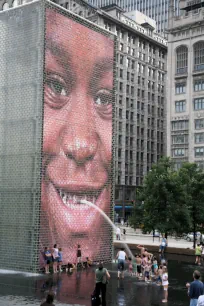Built on a site that was controlled by the Illinois Central Railroad for almost 150 years, Millennium Park is seen by many Chicagoans as the crowning glory of their city. The 24.5 acre (10 ha) Millennium Park is a magnificent modern park with state-of-the-art facilities, unique public artwork and beautiful gardens.
History of the Park
Millennium Park is bordered by Michigan Avenue to the west, Columbus Drive to the east, Randolph Street to the North and Monroe Street to the South. It sits in an area that was once considered sacred to the Illinois Central Railroad. City planners developed Grant Park around the railroad tracks but, for decades, many still considered the area to be one of Chicago’s less-than-beautiful spots.
Civic groups tried to propose a new park and arts pavilion in 1977 but lacked the backing of the government. It wasn’t until the late 1990s that Millennium Park was proposed by Mayor Daly and greeted with much enthusiasm, with a mission of “creating new parkland in Grant Park to transform the unsightly railroad tracks and parking lots that had long dotted the lakefront”. This was achieved by constructing the park on top of the railroad yard.

transform the unsightly railroad tracks and parking lots that had long dotted the lakefront. This was achieved by constructing the park on top of the railroad yard.
Plans were to open the park in 2000, hence its name, but problems with the original contractor – who missed several deadlines and went well over budget – delayed the project. The park finally opened in July 2004. It was worth the wait though, as Millennium Park is one of Chicago’s most spectacular sights.
What You’ll Find There

Today, Millennium Park is a hubbub of activity nearly all year long. It’s become well-known for its architecture and landscape design, and has won awards for the innovative features found in the park.
Pritzker Pavilion
The centerpiece of the Millennium Park is the Frank Gehry-designed Jay Pritzker Pavilion. This ultra-contemporary outdoor concert venue seats 4,000 with room for an additional 7,000 on the Great Lawn. Its design is spectacular and its sound system state-of-the-art. A host of different genres of concerts and other events are held at the Pritzker Pavilion at least once-a-week.
Harris Theater
If you prefer indoor concerts or theater, visit the Joan W. and Irving B. Harris Theater for Music and Dance. This theater seats just over 1,500 people and is perfect for more intimate events, such as ballets or chamber music concerts.
Crown Fountain
Kids and adults alike love the innovative Crown Fountain.

The fountain, designed by Spanish artist Jaume Plensa, consists of two 50-foot (15 m) glass block towers at each end of a shallow, sparkling reflecting pool. The towers project video images of diverse Chicago citizens spitting out water, which Plensa claims is a reference to the traditional use of gargoyles, where faces of mythological beings were sculpted with open mouths to allow water to flow out.
Lurie Garden
Outdoor enthusiasts will also enjoy the 2.5-acre (1 hectare) Lurie Garden. Hundreds of colorful flowers and green shrubs cover the garden. You’ll find mostly native plants, a reference to the tall prairie grasses found in Illinois. A 15-foot-high (4.5 m) “shoulder” hedge represents Carl Sandburg’s famous description of Chicago as the “City of the Big Shoulders”.
Cloud Gate
Architecture buffs will also enjoy the quirky Cloud Gate, designed by British artist Anish Kapoor. This bean-shaped structure was inspired by liquid mercury and is among the largest sculpture of its kind in the world, measuring 66-feet long by 33-feet high (20 x 10 meter). It weighs a whopping 100 tons and is made of polished stainless steel plates.
The shiny material reflects the magnificent Chicago skyline. The 12-foot-high arch (3.7 m) in the middle of the sculpture serves as a gate and welcomes visitors to walk under the structure, touch the steel, and view the distorted reflections of themselves and their companions.
BP Footbridge

Complementing the Pritzker Pavilion in design, the magnificent 925-foot-long (282 meter) winding BP Bridge – often referred to as the ‘Snake Bridge’ – is well worth a stroll. Connecting Millennium Park with Daley Bicentennial Plaza, the Frank Gehry-designed masterpiece provides great views of Lake Michigan and the Chicago skyline.
Brushed stainless steel panels line the sides of the unique bridge and provide an acoustic barrier for traffic noise as it crosses busy Columbus Avenue. The hardwood deck is easily maneuverable for visitors with disabilities.
More attractions

You’ll also want to make a stop at the classic Millennium Monument, with its stately Doric columns rising 40 feet (12 meter) in the air. At the center of the monument is the Millennium Fountain.
Winters take visitors to the McCormick Tribune Plaza and Ice Rink, boasting state-of-the-art ice-making machines that can even withstand unusually warm winter weather.
You can also enjoy changing exhibits along the Chase Promenade and have a chance to view local art at the Boeing Galleries. The Exelon Pavilions house Millennium Park’s excellent visitor center, a great place to start your tour if you’re new to the park.
- Next: Marina City
- More Sights & Attractions in Chicago



